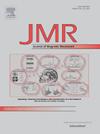PP-SNMR measurements using SQUIDs as compact three-component B-field sensors for spatial imaging
IF 1.9
3区 化学
Q3 BIOCHEMICAL RESEARCH METHODS
引用次数: 0
Abstract
We present pre-polarization surface nuclear magnetic resonance (PP-SNMR) measurements performed with a Superconducting QUantum Interference Device (SQUID) magnetometer on water-filled pallet boxes. The SQUID directly detects the three components of the magnetic field (B-field) NMR response, while conventional SNMR experiments would detect its time derivative and most of the time only a single component. Each of the three vector components of the magnetic field NMR response consists of a component oscillating at Larmor frequency and of a non-oscillating component. We extend the general SNMR theory to model the measured signals. For the non-oscillating signal, another magnetic decay with a large amplitude is superimposed on the signal originating from the water-filled boxes, and we were unable to extract the desired signal. For the oscillating signal component, however, we report good agreement between the measured signal and the forward model in amplitude and phase. Measuring all three components of the B-field introduces a sensitivity to lateral inhomogeneities, which we demonstrate by repeating the experiment with one and two emptied boxes.

PP-SNMR测量使用squid作为紧凑的三分量b场传感器进行空间成像
我们提出了极化前表面核磁共振(PP-SNMR)测量与超导量子干涉装置(SQUID)磁强计在装满水的托盘箱。SQUID直接检测磁场(b场)核磁共振响应的三个分量,而传统的SNMR实验只检测其时间导数,而且大多数时候只检测单一分量。磁场核磁共振响应的三个矢量分量中的每一个都由一个以拉莫尔频率振荡的分量和一个非振荡分量组成。我们扩展了一般的SNMR理论来模拟测量信号。对于非振荡信号,另一个振幅较大的磁衰减叠加在来自充水盒的信号上,我们无法提取所需的信号。然而,对于振荡信号分量,我们报告了测量信号与正演模型在幅度和相位上的良好一致性。测量b场的所有三个分量引入了对横向不均匀性的敏感性,我们通过用一个和两个空盒子重复实验来证明这一点。
本文章由计算机程序翻译,如有差异,请以英文原文为准。
求助全文
约1分钟内获得全文
求助全文
来源期刊
CiteScore
3.80
自引率
13.60%
发文量
150
审稿时长
69 days
期刊介绍:
The Journal of Magnetic Resonance presents original technical and scientific papers in all aspects of magnetic resonance, including nuclear magnetic resonance spectroscopy (NMR) of solids and liquids, electron spin/paramagnetic resonance (EPR), in vivo magnetic resonance imaging (MRI) and spectroscopy (MRS), nuclear quadrupole resonance (NQR) and magnetic resonance phenomena at nearly zero fields or in combination with optics. The Journal''s main aims include deepening the physical principles underlying all these spectroscopies, publishing significant theoretical and experimental results leading to spectral and spatial progress in these areas, and opening new MR-based applications in chemistry, biology and medicine. The Journal also seeks descriptions of novel apparatuses, new experimental protocols, and new procedures of data analysis and interpretation - including computational and quantum-mechanical methods - capable of advancing MR spectroscopy and imaging.

 求助内容:
求助内容: 应助结果提醒方式:
应助结果提醒方式:


